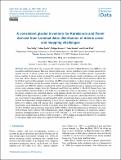Files in this item
A consistent glacier inventory for Karakoram and Pamir derived from Landsat data : distribution of debris cover and mapping challenges
Item metadata
| dc.contributor.author | Mölg, Nico | |
| dc.contributor.author | Bolch, Tobias | |
| dc.contributor.author | Rastner, Philipp | |
| dc.contributor.author | Strozzi, Tazio | |
| dc.contributor.author | Paul, Frank | |
| dc.date.accessioned | 2019-03-13T15:30:07Z | |
| dc.date.available | 2019-03-13T15:30:07Z | |
| dc.date.issued | 2018-10-10 | |
| dc.identifier | 258135339 | |
| dc.identifier | 2ed98438-742a-44d9-ae70-b44ec7ea36bb | |
| dc.identifier | 85054693653 | |
| dc.identifier.citation | Mölg , N , Bolch , T , Rastner , P , Strozzi , T & Paul , F 2018 , ' A consistent glacier inventory for Karakoram and Pamir derived from Landsat data : distribution of debris cover and mapping challenges ' , Earth System Science Data , vol. 10 , no. 4 , pp. 1807-1827 . https://doi.org/10.5194/essd-10-1807-2018 | en |
| dc.identifier.issn | 1866-3508 | |
| dc.identifier.other | ORCID: /0000-0002-8201-5059/work/55379184 | |
| dc.identifier.uri | https://hdl.handle.net/10023/17277 | |
| dc.description.abstract | Knowledge about the coverage and characteristics of glaciers in High Mountain Asia (HMA) is still incomplete and heterogeneous. However, several applications, such as modelling of past or future glacier development, run-off, or glacier volume, rely on the existence and accessibility of complete datasets. In particular, precise outlines of glacier extent are required to spatially constrain glacier-specific calculations such as length, area, and volume changes or flow velocities. As a contribution to the Randolph Glacier Inventory (RGI) and the Global Land Ice Measurements from Space (GLIMS) glacier database, we have produced a homogeneous inventory of the Pamir and the Karakoram mountain ranges using 28 Landsat TM and ETM+ scenes acquired around the year 2000. We applied a standardized method of automated digital glacier mapping and manual correction using coherence images from the Advanced Land Observing Satellite 1 (ALOS-1) Phased Array type L-band Synthetic Aperture Radar 1 (PALSAR-1) as an additional source of information; we then (i) separated the glacier complexes into individual glaciers using drainage divides derived by watershed analysis from the ASTER global digital elevation model version 2 (GDEM2) and (ii) separately delineated all debris-covered areas. Assessment of uncertainties was performed for debris-covered and clean-ice glacier parts using the buffer method and independent multiple digitizing of three glaciers representing key challenges such as shadows and debris cover. Indeed, along with seasonal snow at high elevations, shadow and debris cover represent the largest uncertainties in our final dataset. In total, we mapped more than 27 800 glaciers >0.02 km2 covering an area of 35 520±1948 km2 and an elevation range from 2260 to 8600 m. Regional median glacier elevations vary from 4150 m (Pamir Alai) to almost 5400 m (Karakoram), which is largely due to differences in temperature and precipitation. Supraglacial debris covers an area of 3587±662 km2, i.e. 10 % of the total glacierized area. Larger glaciers have a higher share in debris-covered area (up to >20 %), making it an important factor to be considered in subsequent applications (https://doi.org/10.1594/PANGAEA.894707). | |
| dc.format.extent | 21 | |
| dc.format.extent | 18312427 | |
| dc.language.iso | eng | |
| dc.relation.ispartof | Earth System Science Data | en |
| dc.subject | Earth and Planetary Sciences(all) | en |
| dc.subject | DAS | en |
| dc.subject | SDG 15 - Life on Land | en |
| dc.title | A consistent glacier inventory for Karakoram and Pamir derived from Landsat data : distribution of debris cover and mapping challenges | en |
| dc.type | Journal article | en |
| dc.contributor.institution | University of St Andrews. School of Geography & Sustainable Development | en |
| dc.contributor.institution | University of St Andrews. Bell-Edwards Geographic Data Institute | en |
| dc.identifier.doi | https://doi.org/10.5194/essd-10-1807-2018 | |
| dc.description.status | Peer reviewed | en |
This item appears in the following Collection(s)
Items in the St Andrews Research Repository are protected by copyright, with all rights reserved, unless otherwise indicated.

